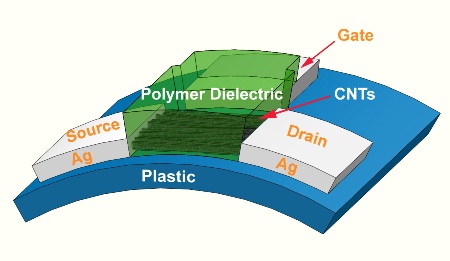A team of scientists at Aneeve Nanotechnologies has utilized inexpensive ink-jet printing technology to create the first-of-its-kind circuits comprising top-gated and printed back-gated electronics based on carbon nanotubes for OLED display applications.
 Ink-jet-printed circuit (credit: UCLA CNSI)
Ink-jet-printed circuit (credit: UCLA CNSI)
In this work, Aneeve Nanotechnologies team has developed increased on-off ratio and high-mobility carbon nanotube thin-film transistors using ink-jet printing technology. The team has exhibited the first-of-its-kind completely printed single-pixel OLED control circuits, whose performance benefits were better than that of conventional organic-based printed electronics.
Kos Galatsis, Co-Founder of Aneeve Nanotechnologies and UCLA Engineering’s Associate Adjunct Professor of Materials Science, stated that for the first time, printed circuits based on carbon nanotubes were demonstrated for display backplane applications. The company illustrated the feasible candidacy of carbon nanotubes as a scalable and inexpensive technology along with metal-oxide semiconductor and amorphous silicon solutions, Galatsis added.
The use of an ink-jet printing technology avoids the requirement for costly vacuum equipment and facilitates scalable production and roll-to-roll printing. Aneeve Nanotechnologies tackled several issues associated with material integration, created new cleaning methods and developed new processes for using nano-based ink solutions.
According to the researchers, the OLED arrays will be completely incorporated with the printed carbon nanotube transistors for active-matrix OLED applications. The carbon nanotube-based thin-film transistors will be placed safely due to the encapsulation technology designed for OLEDs, whose organics have high sensitivity to moisture and oxygen.